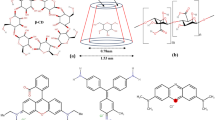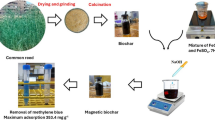Abstract
Crosslinked polyacrylamide hydrogel was used in the adsorption of heavy metals; lead, copper, and cadmium. The effect of different parameters, pH, temperature, and concentration of the metallic solution on the adsorption were studied. The metal ion removal capacities changed depending on the nature of the metal, the PAAM hydrogel were highly selective to Pb(II) ions. Under optimal conditions, the maximum adsorption capacity of Pb(II) Cu(II), and Cd(II) were 442.31, 331.59, and 216.26 mg/g, respectively. In addition, the research of kinetics and isotherms displayed that the pseudo-second-order kinetic model and the Langmuir isotherm model fitted the data well regardless of the adsorbed metal studied. PAAM was also regenerated over multiple adsorption cycles without any appreciable loss of its adsorption capacity.












Similar content being viewed by others
REFERENCES
F. Qin, B. Wen, X. Shan, et al., Environ. Pollut. 144, 669 (2006).
Y. Essaadaoui, A. Lebkiri, E. Rifi, et al., Desalin. Water Treatm. 111, 267 (2018).
M. Ajmal, R. Ali Khan Rao, S. Anwar, et al., Bioresour. Technol. 86, 147 (2003).
U. Kumar and M. Bandyopadhyay, Bioresour. Technol. 97, 104 (2006).
K. Kadirvelu, K. Thamaraiselvi, and C. Namasivayam, Bioresour. Technol. 76, 63 (2001).
M. Wiśniewska, G. Fijałkowska, and K. Szewczuk-Karpisz, Chemosphere 211, 524 (2018).
A. Ouass, Y. Essaadaoui, L. Kadiri, et al., E3S Web Conf. 37, 02001 (2018).
C. B. Godiya, X. Cheng, D. Li, et al., J. Hazard. Mater. 364, 28 (2019).
H. Kaşgöz, S. Özgümüş, and M. Orbay, Polymer 44, 1785 (2003).
N. Yuan, L. Xu, L. Zhang, et al., Mater. Sci. Eng. C 67, 221 (2016).
R. Liu, S. Liang, X.-Z. Tang, et al., J. Mater. Chem. 22, 14160 (2012).
C. Zhou, Q. Wu, T. Lei, and I. I. Negulescu, Chem. Eng. J. 251, 17 (2014).
Z. Yang, H. Yang, Z. Jiang, et al., J. Hazard. Mater. 254–255, 36 (2013).
X. Wei, J. Tao, M. Li, et al., Mater. Chem. Phys. 192, 72 (2017).
F. Yang, G. Li, Y.-G. He, et al., Carbohydr. Polym. 78, 95 (2009).
R. I. Baron, M. Bercea, M. Avadanei, et al., Int. J. Biol. Macromol. 123, 744 (2019).
L. Kadiri, A. Lebkiri, E. H. Rifi, et al., Int. J. Sci. Eng. Res. 8 (7), 6 (2017).
I. Lebkiri, B. Abbou, L. Kadiri, et al., Mediterr. J. Chem. 9, 337 (2019).
Z. Mahdi, A. El Hanandeh, and Q. J. Yu, J. Environ. Chem. Eng. 7, 103379 (2019).
X. Wang, L. Wang, Y. Wang, et al., Crystals 7, 270 (2017).
J. Sebastia, J. Labanowski, and I. Lamy, Chemosphere 68, 1245 (2007).
X. Gu, L. J. Evans, and S. J. Barabash, Geochim. Cosmochim. Acta 74, 5718 (2010).
K. Wang, J. Gu, and N. Yin, Ind. Eng. Chem. Res. 56, 1880 (2017).
A. Chakir, J. Bessiere, K. E. Kacemi, and B. Marouf, J. Hazard. Mater. 95, 29 (2002).
L. Kadiri, A. Lebkiri, E. H. Rifi, et al., E3S Web Conf. 37, 02005 (2018).
F.-Q. An, R.-Y. Wu, M. Li, et al., React. Funct. Polym. 118, 42 (2017).
A. J. Bora and R. K. Dutta, J. Water Process Eng. 31, 100839 (2019).
H. Freundlich, Z. Phys. Chem. 57U (1) (1907).
A. O. Dada, A. P. Olalekan, A. M. Olatunya, and O. Dada, IOSR J. Appl. Chem. 3, 38 (2012).
B. Abbou, I. Lebkiri, H. Ouaddari, et al., J. Turk. Chem. Soc. Sect. Chem. 8, 677 (2021).
Q. Kong, B. Xie, S. Preis, et al., RSC Adv. 8, 8950 (2018).
J. He, Y. Li, C. Wang, et al., Appl. Surf. Sci. 426, 29 (2017).
B. Abbou, I. Lebkiri, H. Ouaddari, et al., Turk. J. Chem. 45, 362 (2021).
U. Fifi, T. Winiarski, and E. Emmanuel, Int. J. Environ. Res. Publ. Health 10, 5830 (2013).
P. C. Gomes, M. P. F. Fontes, A. G. da Silva, et al., Soil Sci. Soc. Am. J. 65, 1115 (2001).
J. Cao, Y. Tan, Y. Che, and H. Xin, Bioresour. Technol. 101, 2558 (2010).
İ. Lebkiri, B. Abbou, L. Kadiri, et al., J. Turk. Chem. Soc. Sect. Chem. 8, 731 (2021).
ACKNOWLEDGMENTS
We gratefully acknowledge the Technical Support Units for Scientific Research (UATRS) under the National Center for Scientific and Technical Research (CNRST), especially to Hanae OUAADARI for the analytical services and instrumentations. We also thank our laboratory members for their generous help.
Author information
Authors and Affiliations
Corresponding authors
Ethics declarations
The authors declare that they have no conflicts of interest.
Rights and permissions
About this article
Cite this article
Lebkiri, I., Abbou, B., Kadiri, L. et al. Polyacrylamide Hydrogel an Effective Adsorbent for the Removal of Heavy Metal from Aqueous Solution: Isotherm, Kinetic, and Thermodynamic Studies. Russ. J. Phys. Chem. 96, 1484–1492 (2022). https://doi.org/10.1134/S0036024422070159
Received:
Revised:
Accepted:
Published:
Issue Date:
DOI: https://doi.org/10.1134/S0036024422070159




